Introduction For all Martina and I’s backpacking over the years, we have actually done very little long distance walks in our home country of Scotland. I guess one of the reasons is that we have explored Scotland extensively as part of hillwalking, climbing, kayaking and other trips such that there is less of a sense of discovery for us here. Not to say that Scotland isn’t fantastic with its beautiful mix of hills, sea and islands, ever changing light and accessibility throughout the year. And there is still plenty new for us to see, particularly around the coasts. But Scotland also does have challenges for backpacking over many days, with principle adversaries being wet weather with boggy underfoot conditions and, in summer- the midge!
The Isle of Skye though has a potentially wonderful backpack of about 7 days duration and 80 miles (130km) called the Skye Trail. Brian thought he would give it a go in the autumn of 2022….
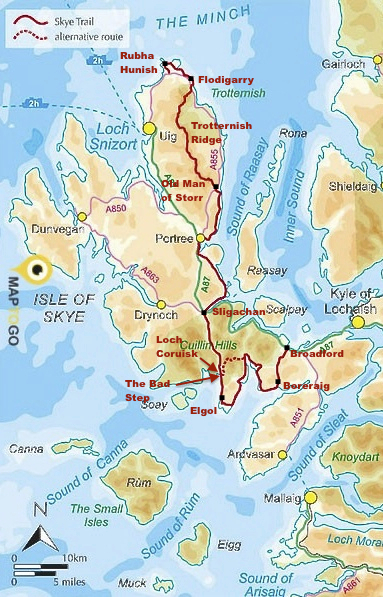
What’s it like? The Isle of Skye sits off the north west coast of Scotland. Its both mountainous and has a rugged coastline and the trail goes through both. There are some tremendous landscapes and, maybe I am biased, but the scenery is world class in places. In the south are the Cuillin mountains which are the most rugged in the British Isles. In the north is the Trotternish Ridge where the trail traverses a long undulating ridge with splendid views and other worldly rock formations at either end. The coastal sections are equally good, particularly around Elgol in the south and Flodigarry to Rubha Hunnish in the north. That’s a lot of excitement to pack into 7 days! I have a short description of my hike below as well as some notes on planning further on.
My hike south to north
Day 1 Broadford to Torrin This was a short easy day. I started late from Broadford around 4pm but still made it just short of Torrin to camp at the bay of Camus Malag before joining road. The trails are dry making for relaxed walking over to the coast at Boreraig, with its town ruins evidence of Highland Clearances described in Walkhighlands. There is a lovely coastal path round to Loch Slapin and the views of the mountain Blabheinn (pronounced Blaven) in particular are spectacular. A really enjoyable mellow start.
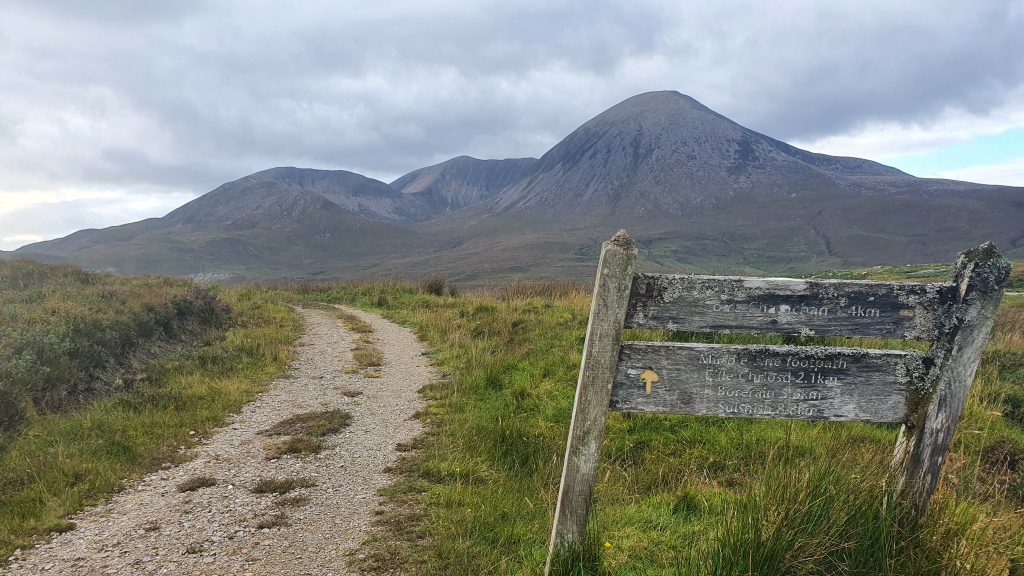



Day 2 Torrin to Elgol to Camasunary This is another short guidebook day and I hiked on from Elgol for an extra few hours to camp to the north at Camasunary Bay. I started with a road walk through the small settlement of Torrin (the cafe was closed unfortunately!) and round the head of Loch Slapin. Good views to the mountains here and there is roadside camping opportunities next to the sea but you may need to share with campervans. The route leaves the road at the Blaven trailhead following a trail south for about 4km to return to the tarmac.
[Note that you could do a wild alternate here by hiking to the summit of Blaven, then down its south ridge to Camasunary. The panoramic views are great, but its a 3000 feet climb with rough ground on the descent and some scrambling. One for good weather. Maybe on balance I would recommend the Coruisk – Sgurr na Stri alternative below instead].
I had showers and rainbows as I hiked through Kirkibost [a shortcut alternate takes you direct to Camasunary from south of here on a landrover track but its not as good as the normal route]. then a series of again viewful tracks south above the coast to near Spar Cave. I didn’t visit the cave but I think it would be a superb diversion-note you need a low tide to access it.
Another quiet road headed east over to Elgol. More great views out to sea and across to the Isle of Rum here.
I stopped at Elgol for a late lunch before turning north on a excellent trail to Camasunary. This was the best section so far as I headed along the, at times exposed, trail looking to the Cuillin mountains. You could camp at Glen Scaladal, there is some beach plastic ‘flotsom and jetsom’ but its still a good spot. I stopped beyond at Camasunary Bay to camp (there is also a popular bothy here you could stay at). Superb day.



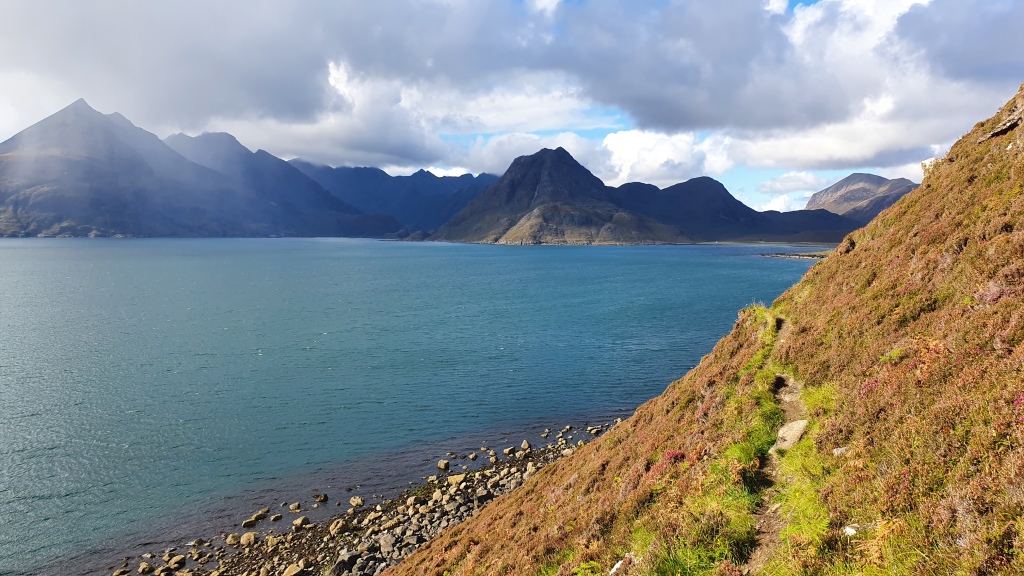
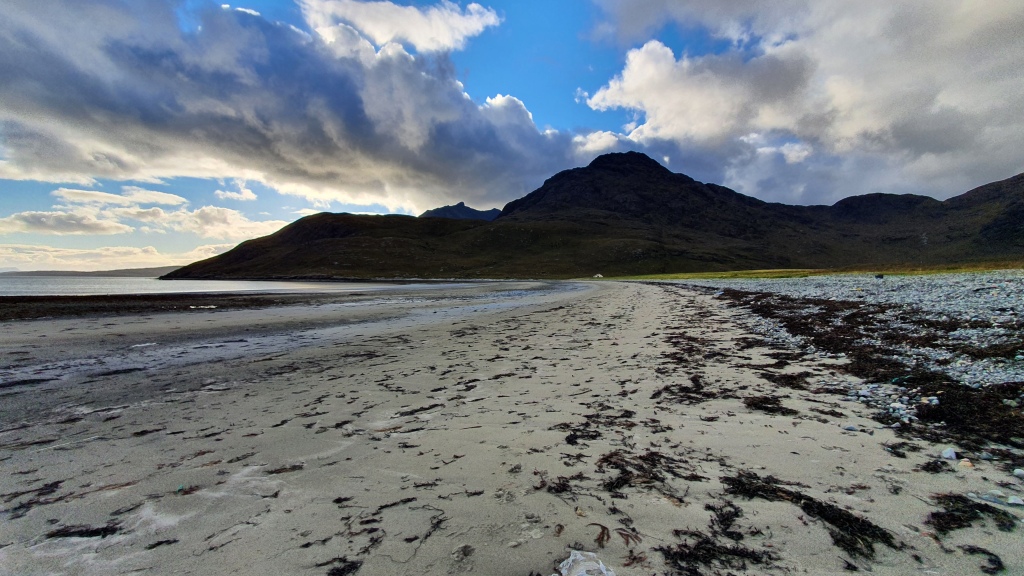
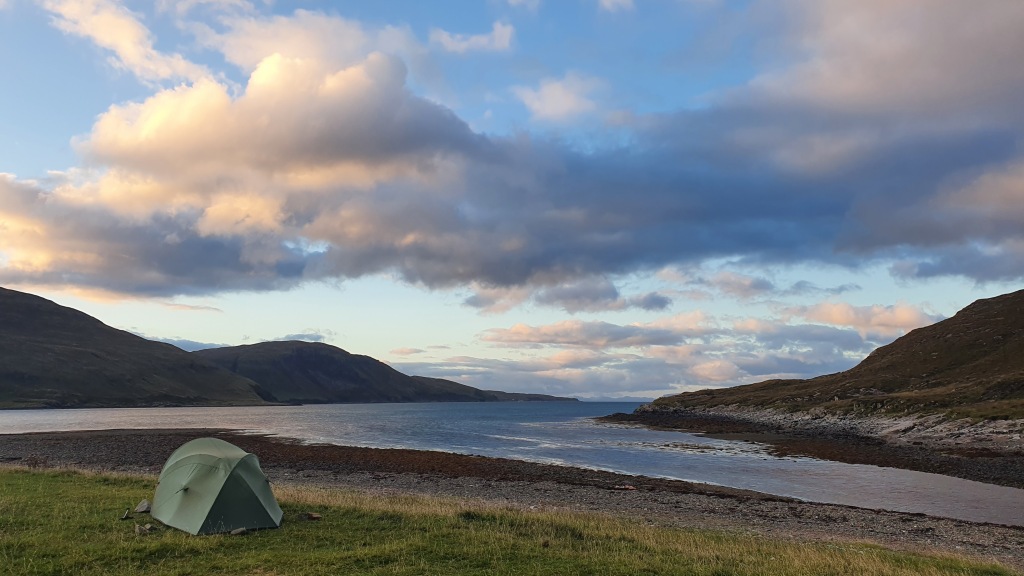

Day 3 Camasunary to Sligachan The normal route here is straightforward following Glen Sligachan north on a good trail. This provides everchanging views to the Cuillin peaks above but stays low in a valley and misses the Cuillin’s themselves which is a pity.
I took a somewhat more interesting route round the coast to Loch Coruisk via the ‘Bad Step’, then along the south of Loch Coruisk, up over the Cuillin ridge at the pass Bealach na Glaic Moire then after some scrabbling scree descents I connected with trails on the west of the mountains to Sligachan. Description and map of the options below
My day started with a crossing of the river west of Camasunary over some stepping stones about 300m inland from the sea. I managed to stay dry which was a bonus as I have been soaked here before as it’s tidal and the river rises a lot during wet spells. Next up was a grand rough trail round the coast to the outlet of Loch Coruisk. This is atmospheric territory and reaches a crescendo at the ‘Bad Step’ – a sloping slab of rock perched above the sea. It is short and requires a Grade 2 (US Class 4 maybe) scramble using a crack line as a hand rail. Once past that I followed a faint trail through a short section of boulders and deep vegetation before exiting out over a shallow pass to Loch Coruisk. This was a fantastic spot with the loch walled in by imposing mountains.
There was a strong wind funneling down the loch and it was tough going along the lochside with lots of bog then a steep haul up to the high pass, Bealach na Glaic Moire, on the Cuillin ridge itself. I stopped for lunch hunched down behind a boulder from the gale force winds but the views were superb. The descent involved some (to be honest unpleasant) steep scree before I picked up a good trail above the crowded ‘Instagram spot’ of the Fairy Pools. I sped on over the pass, Bealach a’ Mhaim, with heavy rain showers preventing me stopping for a brew of tea to relax. There are beautiful waterfalls on the way to Sligachan which are quiet- unlike the Fairy Pools -and would be great for a dip if it was a bit warmer! Another superb day.


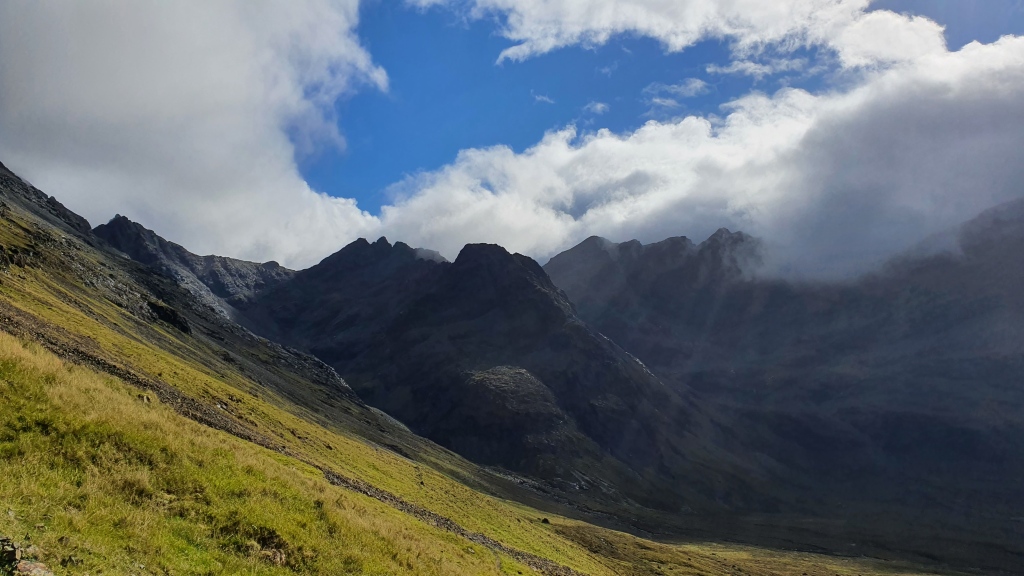
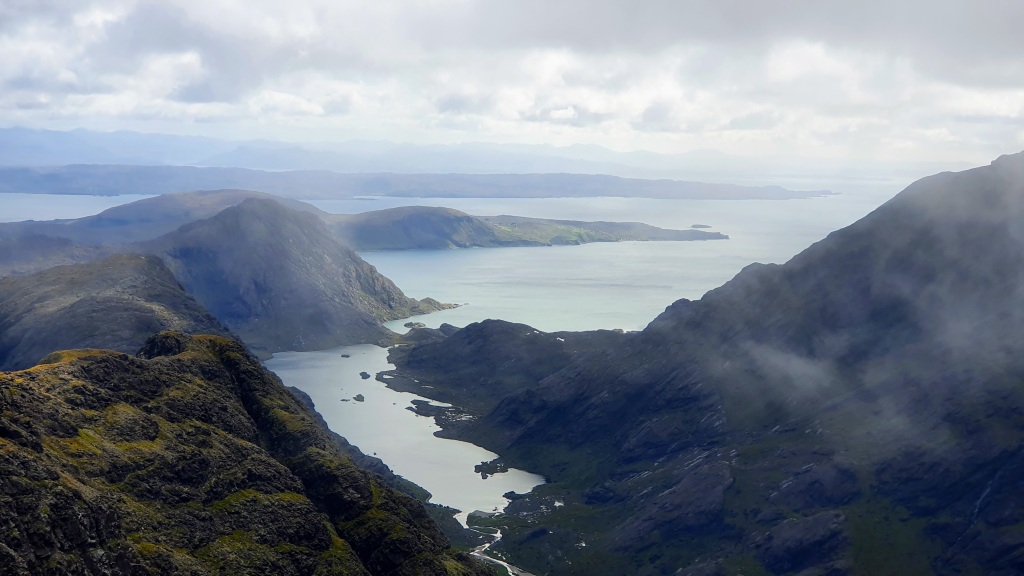
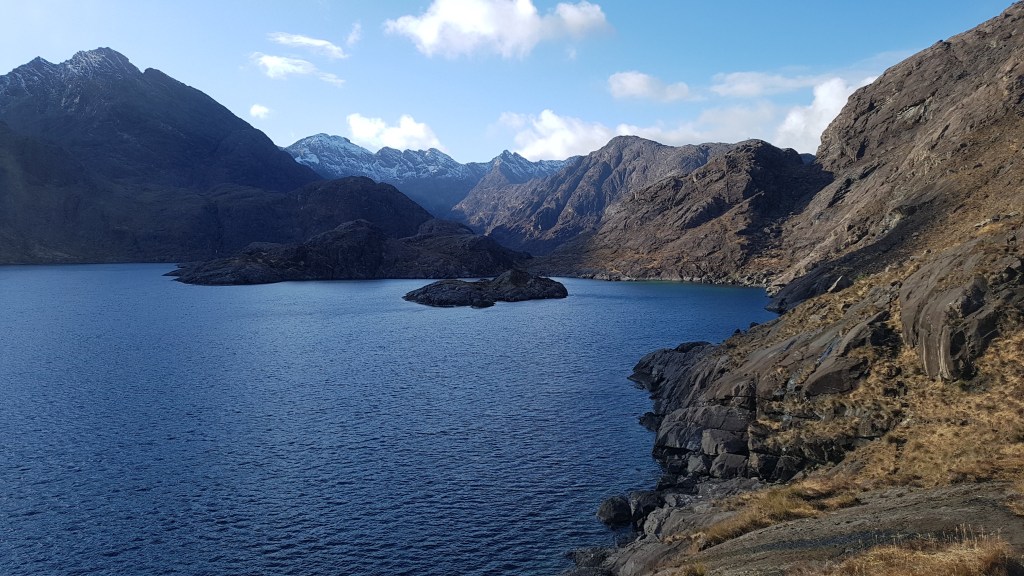
I think a better variant between Camasunary and Sligachan that I would recommend to maximise the drama and scenery is via Coruisk – Sgurr na Stri.

Red- normal route
Purple – Coruisk – Sgurr na Stri recommended variant
Purple dashes – My route September 2022
Purple dots-A better alternate to my route following the Druim nan Ramh ridge but with a scramble at the top
Coruisk – Sgurr na Stri From Camasunary cross the river and take the coastal trail to the west past the ‘Bad Step’ (Grade 2 scramble) to Loch Coruisk. Take the trail north over a pass before descending down into Glen Sligachan and the main Skye Trail. Better still is to also cut back south on a trail to the summit of Sgurr na Stri for some brilliant views. Return back to the trail to Glen Sligachan.


Day 4 Sligachan to Portree This is the least interesting day of the hike, more of a connector between the Cuillin mountains and the Trotternish ridge north of Portree. On the plus side the views can be good reducing the slightly dull 10.5km of road walking. I set off from Sligachan campsite in dark cloudy weather and followed the pleasant path along the north shore of Loch Sligachan. Views are good (again!) and you see the Raasay ferry setting off on its short voyage. Unfortunately the sky’s opened once I hit the minor road so it was heads down from there into Portree for me!

Day 5 Portree to The Storr trailhead It was raining hard in Portree and checking the forecast showed more rain for the next three days so I reluctantly stopped at this point and intend to return to backpack the remaining 3 days in better weather!
I did do this section in May 2021 though. A good trail leads round Portree harbour and bay- I saw both sea eagles and golden eagles on the climb out onto the ridge to the north. Views back to the Cuillin mountains and over to Raasay are splendid. It gets a bit boggier descending north but there is a short road you meet above Bearreraig Bay. I took the steep path down to the bay past the hydro station to its cool beach and fossils. A short but excellent day with Portree bay and a ridge walk.
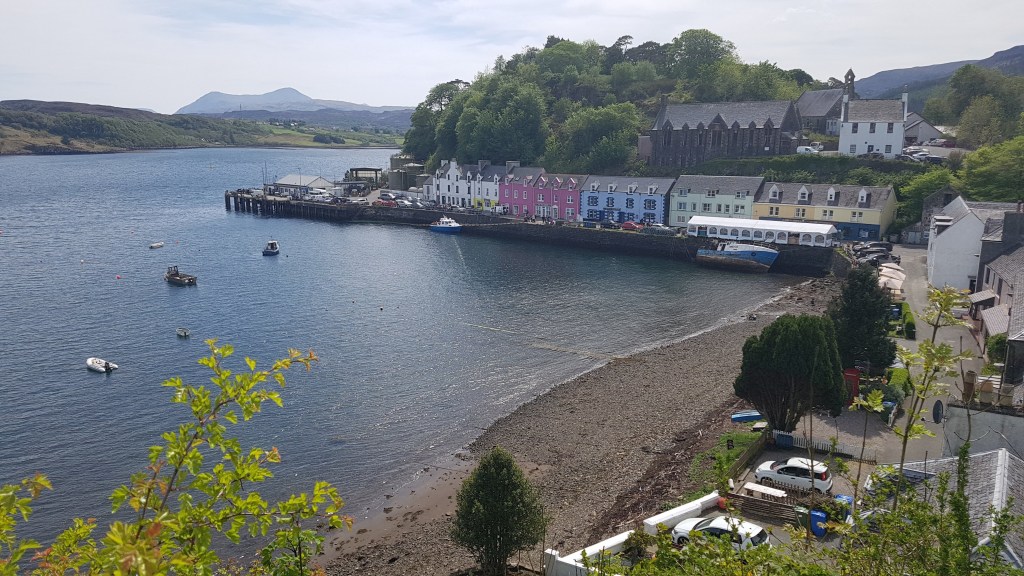

Day 6 The Storr to Flodigarry – Trotternish ridge Again I have hiked this ridge in the past and it is a brilliant undulating grassy ridge walk with expansive views. To the east are the hills of the mainland and the isles of Raasay and Rona. To the west are the island chain of the Outer Hebrides. At both ends are the weird rock formations of The Storr in the south and The Quirang in the north. Try and savor all of this on a good weather day.


Day 7 Flodigarry to Rubha Hunish and Duntulm A mostly cross country coastal walk to Sky’s most northerly point Rubha Hunish which has a wild spacious feel looking out across the sea to Harris.


Planning Walkhighlands has an excellent web guide. Cicerone also a has a detailed guidebook available in paper or eBook. I think the Harvey Maps Skye Trail paper map is also very useful. No permits are required, you can wild camp easily outside the towns and access to drinking water isn’t a problem. There are good bus services down the length of the island connecting the start and finish, as well as Portree and Sligachan. Check the guides or use an app such as Google Maps.

Best direction I don’t think it matters too much. However if you are flexible then checking the forecast wind for the week (see links below) and hiking with the wind might prove a good idea.
If you are not wild camping then you have a long, exposed day along the Trotternish ridge between The Storr carpark and Flodigarry in the north. It might be best to do this near the end of the trip and thus hike northwards so you have time to ‘warm up’ before tackling this stage. If you are wild camping it doesn’t matter as you could pitch your tent along the ridge.
Hiking terrain There is a huge mix! From trails, cross country along ridges and coast – and some stretches of tarmac. Expect some bog, especially in wetter periods between Portree and Flodigarry.
I reckon there is about 28km of the 130km total length on tarmac, with the longest stretch being 6.5 miles (10.5km) between Sligachan and Portree in the middle. On the plus side the roads are quiet and the views are mostly extensive, but its a bit more than I would like on a trail.
Best times I will be honest, Skye has a pretty wet climate with the prevailing weather bringing damp air from the Atlantic on south westerly winds. I had a quick look at the web and for example the town of Portree on the Skye Trail has about double the precipitation (1815mm average annual) compared to Tuolumne Meadows in the USA on the Pacific Crest Trail. I suspect Portree is one of the driest parts of the Skye Trail as well! But there are dry spells and mixed cloudy, showery weather can provide clear air and beautiful, atmospheric views.
But when is best? Here are some factors to consider…. April to July is the driest time in Skye. For me from November to February is too dark, wet and boggy. The biting insect called the midge makes itself felt from some time in May to September. Tourists flock to Skye in summer and they won’t impact your hiking but they do make it more difficult and expensive to get accommodation if you need it. So I would say April, May, early June along with late September and early October are the best times to plan in advance – with May perhaps being optimal. That said Skye has very variable weather and can be good or bad any month of the year. Ideally to me it would be best to plan your hike in advance but have some flexibility to look at forecasts before you set off such as: Met office Portree, The Storr, Mountain forecast for North West Scotland

